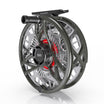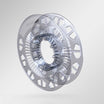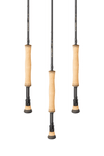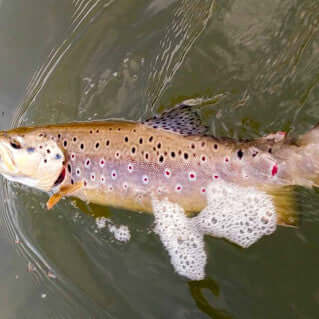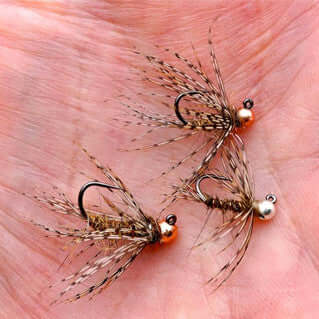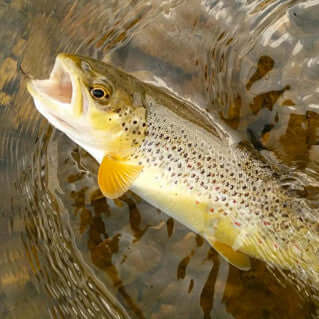It comes to that moment. Calm, as the noise slips away, and it becomes everything I ever wanted fly fishing to be. No complication at all, no sophistication, no artificiality; just natural, raw and real. Alright, I can’t escape or deny all that has happened along the way, the materials and the tools we have designed, the experiences, and the standing on shoulders which have defined the approach, and the entire process.

River San, Poland
Finally, though, it is that moment, this moment, among them all, beautifully translatable, transferable, to any river you like, in any season. This one, perhaps, the San in October, the dark side of the autumnal equinox, and the blue winged olives are beginning their daily show, trickling off, before the cascade hatch. The trout are already going berserk, early, as they must with their, inefficient, high-energy feeding behaviour. My companions have all drifted off to various areas out there among the San enormity, leaving me alone with my moment.

Wild perfection
And I realise, again, that I have stepped off those shoulders for this one. On San, I worked it out pretty much alone, ploughing through what others gave me here, or had shown me on other rivers.
World Championships
I remember when I coached the Australian national team here, in 2010, prior to the World Championship. I remember the morning sessions - busy, theory, demos, trials, - and then in the early afternoon the captain letting loose his team, dispersing wherever each he chose, and leaving me, as now, free and alone. It was the same, every day. I would pause there, as if catching my breath, as the waters slipped by and calm returned. Soon, I was the only presence in the river space that perturbed it, until I was part of the river furniture and that feeling would return.

Grayling from the River San
Picture this, if only you can believe it: there are said to be ten thousand grayling per kilometre of the San tailwater, and probably similar numbers of trout, and obviously the invertebrate life to feed this piscivorous biomass. So, you can go in with all the complications you have picked up from other, lesser, rivers and surely you will catch. Or, you can do something better. You can take a leap of faith, from those shoulders, and leave the noise behind. Listen, instead to what the river tells you. What is this on the surface, and what is this intensity of rising trout? And where are the grayling; are they deep, feeding on nymph, perhaps?
Big Grayling
And as it is, really, the big grayling you want, the reason you are here, should you go with the nymph, ignoring the scrappy trout? Oh yes, I did this a hundred times, honestly, and it was good enough, you think? No, not really. Not since the Aussies were with me. Of course, I caught fish, even some of the big grayling, but it was grossly inefficient and, ordinary somehow, in such a place.

The JL Dry Fly micro thin fly line
And now… I am in position on the bank, not selected for any reason - and certainly not historic, based on fish caught here before - but chosen because of its visual indication that it should hold grayling. There are countless such places on San. Really, countless. A swathe of river opens from the glittering tumble of shingle at my feet into scoops and runs as far as I would really care to wade. The water is San clear, Eastern European clear, and I can glimpse the lovely, life-giving characteristics of good holding water, for both species, but particularly for big grayling.
Seek and you will find
Dark water in channels between plant growth and boulders, a scoop with gravel at the tail, and glide water beyond, where I know grayling will move into as the BWO hatch develops. I think they are there now. There are numerous rises out there, but I think they are almost all trout.
I have choices, although there is only one, really. So I don’t think about the others, while aware I used to worry about them all. Age (or, as I prefer to consider it - experience) frees us from the tyranny of choice.
The plume tip, on a 6’ or 7’ tippet (no leader; completely unnecessary on a micro-thin fly line, no matter what you are told by the conventionalists), pitches in above the shingle just a little way upstream, floating down, untroubled, for all the world like one of the scatter of BWO nearby. Because I do remember, ‘the most important fish is the closest one’, although don’t think about it - and it is not many casts before the first trout whips away the fly. And then, for a while, perhaps half an hour as I nudge out into the river, it is just numbers, clearing through the trout, in impossible numbers. Impossible? Yes, but necessary, because then we are through to the grayling.

Trout fishing heaven
That moment, as the trout dematerialise, the hatch escalates from emerger to dun phase, and grayling dominate the feed lanes. The competitor lives in regret, because he prefers the easy trout. The aficionado is engaged, though, because he knows, just knows, that this is a level far higher. You are out in the river now, twenty yards from that position on the bank where you started. You can’t remember pushing out this far, and the dozen trout and few small grayling along the way. It is not important. Almost accidentally (funny how it happens, more and more) you have found the right stance, with two, no four, five, grayling within range, each of them locking up a prime position in the flow, on the drift of BWO.
Keep that plume tip dry
There is nothing clumsy or contrived out here, and you are not standing on shoulders anymore. You are part of the river, with the greatest prize that this nature can provide. It is just a matter of keeping that plume tip managed, dry, and placing it on the flow accurately, in terms of space and timing, so that when those grayling rise, the fly is there, within an inch of their station. When you have positioned yourself properly, engaging the fish and the flow, it is not difficult, not once you have cleared the trout. And actually, the trout are not that important now, because the big grayling have a way of dominating this particular niche. And it is a natural wonder of the world.
Simple, too. Whoever, said fishing a dry fly came anywhere near close to the complexities of the nymph? Oh, yes, it was the English chalk stream old-school. Not even close to the truth, the fact of the matter. Another world. Really, dry fly is so sublimely simple. Pure though, oh yes, because of this unadulterated simplicity. And given the micro-thin generation of fly lines, obviating the complexities of leader construction, oh, and several thousand hours of river time to cut through the noise, and you have it, right there.

Keep them wet - trout fishing best practise
Such a prize, these magnificent grayling, the ultimate refinement in the gamut of fly fishing possibilities. And with a plume tip on a micro-thin line, offering presentation comparable to fixed leader, tenkara, with none of the drawbacks. Once you have experienced it, you know, finally, the zenith of possibilities, and all else, even those broad shoulders that supported us for so long, are left far, far behind. So, you have a choice, listen to the gurus, listen to me, or (perhaps at least after listening) move on from there.
Keep it simple
You will hear all sorts of nonsense (sorry) about the fly design and its presentation. You hear about angles of attack and imitation of the hatch, of casting technique and, and, and… Ignore it all and keep it as simple as you possibly can. I listen instead to the river, now. I am so grateful for the shoulders that supported me in the past, and the thousand experiences and waypoints on my journey to here. Thankful of discovering the sublime simplicity of the plume tip, and being given the micro-thin fly line, which obviates both leader and conventional fly line.
And thankful too for the San, and the French chalk. But, finally, it is me and the river, any river. It is about how I become part of the river space. For just a while. There is nothing more.






